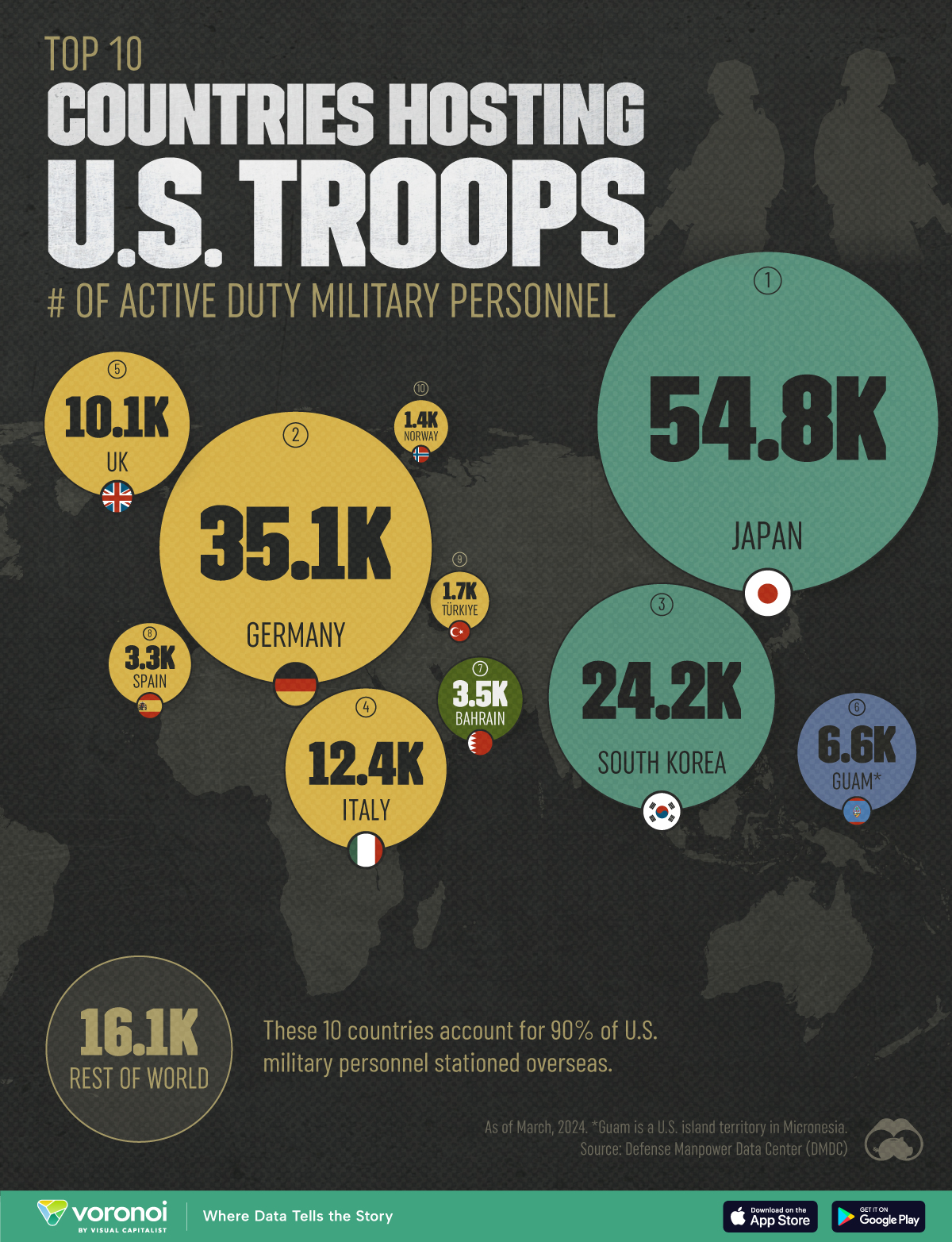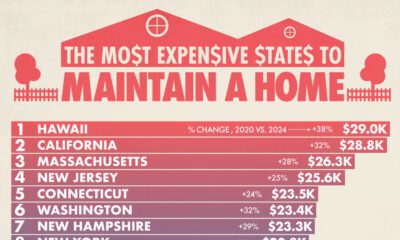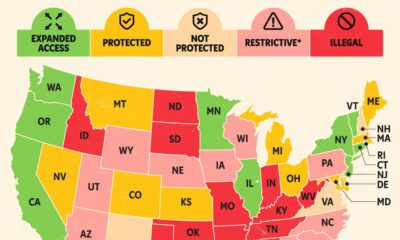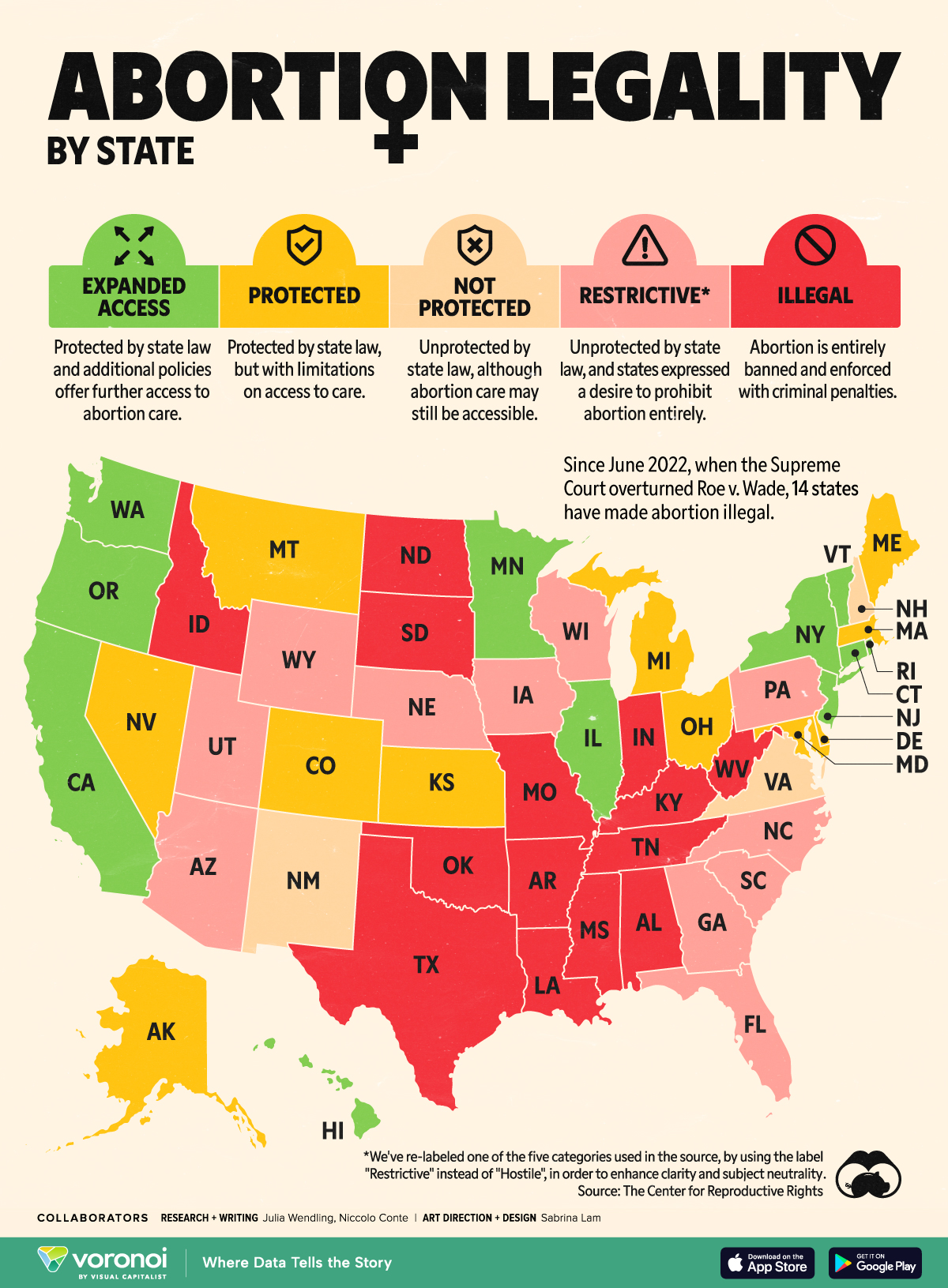Maps
Map: Where are American Troops Stationed Overseas?
![]() See this visualization first on the Voronoi app.
See this visualization first on the Voronoi app.
Map: Where Are American Troops Stationed Overseas?
This was originally posted on our Voronoi app. Download the app for free on iOS or Android and discover incredible data-driven charts from a variety of trusted sources.
With a military budget bigger than most countries’ GDPs, the U.S. military manages to station troops in nearly 170 territories, on every continent in the world.
But which countries host the most troops? We map the territories where active duty American military personnel are stationed, according to March 2024 figures from the Defense Manpower Data Center (DMDC).
Ranked: Top 10 Territories Hosting U.S. Troops
There are nearly 170,000 active duty American troops stationed overseas.
More than half of that number are in Japan (55,000) and Germany (35,000), a holdover from World War II after the Axis powers surrendered.
Germany is now also home to the US European Command (EUCOM) headquarters in Stuttgart. It’s a key regional outpost, to help “keep the peace in Europe, parts of the Middle East, and Eurasia,” as stated by the government.
| Rank | Country | Active Duty American Troops |
|---|---|---|
| 1 | 🇯🇵 Japan | 54,774 |
| 2 | 🇩🇪 Germany | 35,068 |
| 3 | 🇰🇷 South Korea | 24,234 |
| 4 | 🇮🇹 Italy | 12,375 |
| 5 | 🇬🇧 UK | 10,058 |
| 6 | 🇬🇺 Guam* | 6,593 |
| 7 | 🇧🇭 Bahrain | 3,479 |
| 8 | 🇪🇸 Spain | 3,292 |
| 9 | 🇹🇷 Türkiye | 1,690 |
| 10 | 🇳🇴 Norway | 1,438 |
| N/A | 🌍 Rest of World | 16,116 |
| N/A | 🌍 Total | 169,117 |
*Guam is a U.S. territory.
Meanwhile, the Japan-U.S. Security Treaty revised in 1960 allowed America to establish military bases in the country, in exchange for defending Japan in the event of an attack.
South Korea also has a significant garrison, nearly 25,000 active duty personnel. This is also a legacy from the Korean War.
Tellingly, however, six of the top 10 countries hosting U.S. troops are in Europe. For the decades since the Cold War, the American military had been reducing its European footprint. However after Russia’s annexation of Crimea in 2014, the buildup restarted.
Finally, in the wake of the 2022 Russian invasion and the Israel-Hamas war, the U.S. military has increased the number of troops both in Europe and the Middle East.
Maps
Mapped: Abortion Legality by U.S. State
In June 2022, the U.S. Supreme Court overturned Roe v. Wade, opening the door for states to make their own decisions regarding abortion legality. How did states react?
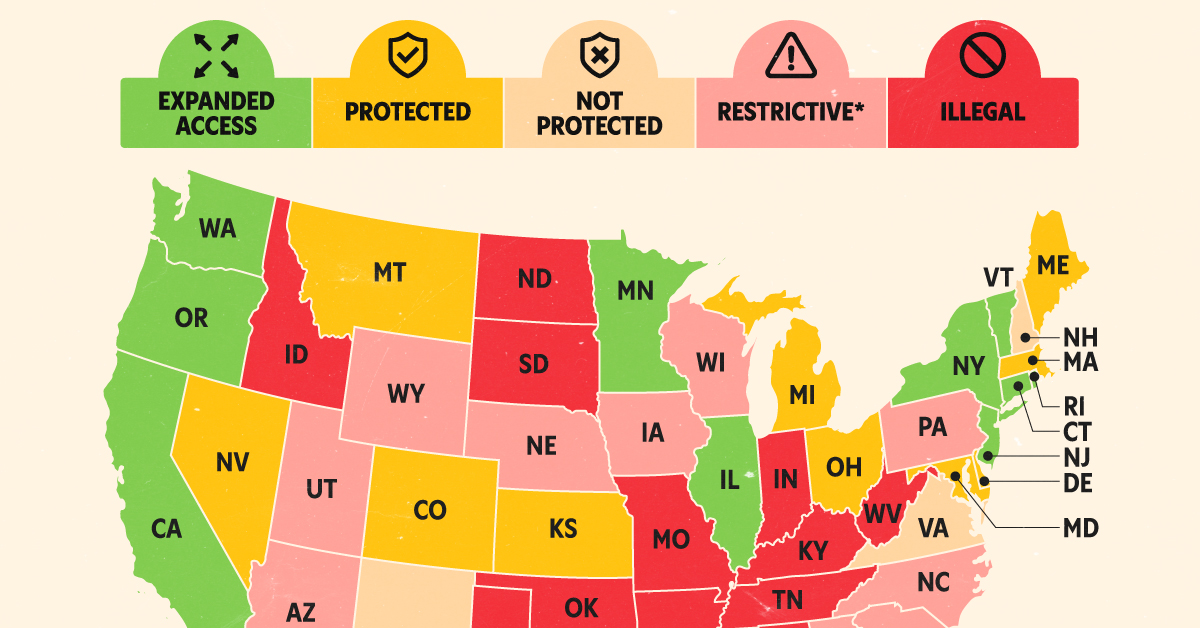
Abortion Legality in America by State
This was originally posted on our Voronoi app. Download the app for free on iOS or Android and discover incredible data-driven charts from a variety of trusted sources.
In June 2022, the U.S. Supreme Court overturned Roe v. Wade, opening the door for states to make their own decisions regarding abortion legality.
In this graphic, we visualize how each U.S. state has altered abortion legality in the post-Roe era, using data from the Center for Reproductive Rights.
What Is Roe v. Wade?
Roe v. Wade refers to the landmark ruling by the Supreme Court in 1973 that dictated that the Constitution of the United States protected an individual’s right to have an abortion.
For over 50 years, the ruling prevented states from banning or significantly restricting abortion to their populations.
As of June 2022, this is no longer the case, as five Supreme Court justices voted to overturn Roe, while four supported maintaining it.
What Happened After Roe Was Overturned?
Since the June 2022 ruling, 14 states—including Texas, Missouri, and much of the South—have made abortion illegal.
| State | Abortion Legality Status |
|---|---|
| Alabama | Illegal |
| Alaska | Protected |
| Arizona | Restrictive |
| Arkansas | Illegal |
| California | Expanded Access |
| Colorado | Protected |
| Connecticut | Expanded Access |
| Delaware | Protected |
| Florida | Restrictive |
| Georgia | Restrictive |
| Hawaii | Expanded Access |
| Idaho | Illegal |
| Illinois | Expanded Access |
| Indiana | Illegal |
| Iowa | Restrictive |
| Kansas | Protected |
| Kentucky | Illegal |
| Louisiana | Illegal |
| Maine | Protected |
| Maryland | Protected |
| Massachusetts | Protected |
| Michigan | Protected |
| Minnesota | Expanded Access |
| Mississippi | Illegal |
| Missouri | Illegal |
| Montana | Protected |
| Nebraska | Restrictive |
| Nevada | Protected |
| New Hampshire | Not Protected |
| New Jersey | Expanded Access |
| New Mexico | Not Protected |
| New York | Expanded Access |
| North Carolina | Restrictive |
| North Dakota | Illegal |
| Ohio | Protected |
| Oklahoma | Illegal |
| Oregon | Expanded Access |
| Pennsylvania | Restrictive |
| Rhode Island | Expanded Access |
| South Carolina | Restrictive |
| South Dakota | Illegal |
| Tennessee | Illegal |
| Texas | Illegal |
| Utah | Restrictive |
| Vermont | Expanded Access |
| Virginia | Not Protected |
| Washington | Expanded Access |
| West Virginia | Illegal |
| Wisconsin | Restrictive |
| Wyoming | Restrictive |
Views on abortion in another 11 states are considered “restrictive,” meaning the states have indicated a desire to ban abortion and have no protections in place. Large variability, however, exists among these states. For example, Florida has restricted abortion after 6 weeks, except in cases where the woman’s life is at risk, whereas Arizona has restricted abortion after 15 weeks.
Conversely, 11 states—predominantly located on the East and West coasts—have moved to increase access to abortions and associated care in the wake of the decision to overturn Roe. Again, variability among this group exists. Oregon and New York have no restrictions based on gestation time. California and Hawaii restrict abortion access at fetal viability (24-26 weeks). Also, states in the “expanded access” category tend to have a higher concentration of abortion clinics, making care more readily accessible.
An additional 11 states have opted to protect abortions rights, though some gestational limitations may still exist. For instance, Kansas has restricted abortions after 22 weeks, but a statewide referendum in August 2022 upheld the right to abortion.
Abortion is accessible to varying degrees in the remaining states, but no specific protections are in place.
Abortion Legality Worldwide
While abortion is legal in many developed countries, it remains prohibited or highly restricted in several others, including the U.S., Poland, Malta, and Ireland.
The U.S. is also one of the few countries to have rolled back abortion laws in the last 30 years. The country is joined by Poland, Nicaragua, and El Salvador who have also tightened abortion legality.
In contrast, over the last three decades, over 60 countries have moved to expand abortion access. As a result, 60% of women who are of reproductive age—totaling 1.12 billion—live in regions where abortion is broadly legal.
See More Graphics about Healthcare
If you found this interesting, check out this visualization on life expectancy trends in the United States.
-

 Misc2 weeks ago
Misc2 weeks agoRanked: The Top 10 U.S. Pizza Chains by Market Share
-

 United States1 week ago
United States1 week agoMapped: Median Income by State in 2024
-

 Markets1 week ago
Markets1 week agoThe Most Popular Stocks in Hedge Fund Portfolios
-

 Markets1 week ago
Markets1 week agoMapped: The World’s Least Affordable Housing Markets in 2024
-

 Energy1 week ago
Energy1 week agoVisualizing Saudi Aramco’s Massive Oil Reserves
-

 Markets1 week ago
Markets1 week agoGDP Per Capita, by G7 Country (2019-2029F)
-

 Sports1 week ago
Sports1 week agoA Look at Cristiano Ronaldo’s Euro Records
-

 Misc1 week ago
Misc1 week agoChart: Which Countries Eat the Most Instant Noodles?

